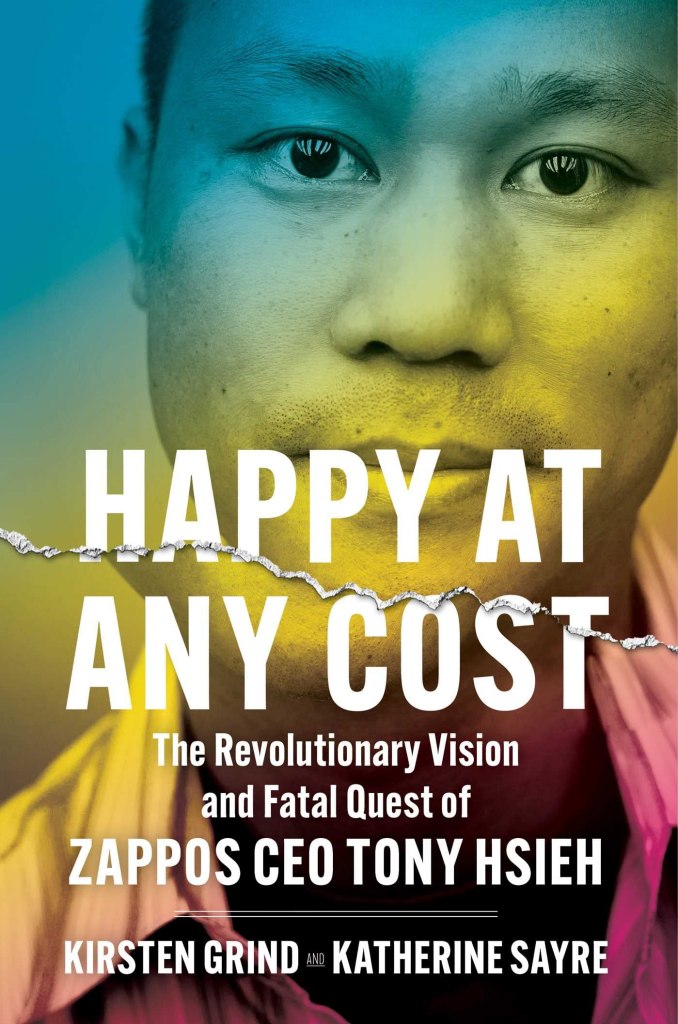
“The Revolutionary Vision and Fatal Quest of Zappos CEO Tony Hsiesh,” is the subtitle.
This book, however, is a tragedy.
Happy at Any Cost is the story of on undoubted visionary leader; their quest for not just their own happiness, but also for the happiness of others. This in turn leads to a lot of good, a lot of success, but ultimately exploitation, substance abuse, and the death of a beloved figure in the world of business and Las Vegas.
Unlike Aimee Groth’s 2017 book “The Kingdom of Happiness” which I reviewed here, and is an inside look at the Las Vegas “Downtown Project” and by extension Zappos, this is the telling of the story of Tony’s last two years as he struggled with mental illness and substance abuse issues put in the wider context of the rest of his life. This is also a cautionary tale for entrepreneurs and for those who can be swept up in vision without dealing with, or caring to deal with, the nuts-and-bolts details that make visions work.
Employing an interesting dual timeline structure, Ms. Grind and Ms. Sayre present an exhaustively researched, and deeply unnerving, tale of Tony Hsieh’s rise and fall. His rise as a tech entrepreneur at Link Exchange, then becoming CEO of what turned into Zappos, his evangelism for company culture with his book Delivering Happiness, and becoming a leading Las Vegas civic figure with the Downtown Project. His fall with the problems with the Downtown Project, issues with Zappos’s adoption of a new company structure called Holocracy, his move to Park City, Utah, his “retirement” from Zappos, and his struggles with alcohol, drugs, and mental illness. It also tells the story of Tony’s last days up to and including his death after a house fire in Connecticut.
Happy at Any Cost very much frames Tony’s life story as a coping mechanism for mental health issues and has the worthy goal of pointing out that if there was not the social stigma long associated with mental health issues perhaps it would have been easier for those around him to help. It is interesting to note, that a reading of Tony’s book Delivering Happiness, particularly in retrospect, leaves the reader with the feeling that the focus on fun and party atmosphere that permeates the book could easily be a coping mechanism for other issues. Where it perhaps most accurately hits the mark is in its exploration that having happiness as a goal in itself as ultimately self-defeating and that happiness should be a by-product of whatever drives you.
I find Tony a fascinating figure to discuss. Someone with gargantuan visions which he often left others to implement. Sometimes that worked and other times it failed. By definition, someone’s legacy is based on what marks they leave behind. Tony was someone who talked about culture and put culture at the front of their business model when nobody, literally nobody, was talking about company culture. For all its flaws, Tony helped rejuvenate Downtown Las Vegas and make it a vibrant hub of new business. However, Tony unbelievably left no will making the unraveling of his estate a legal nightmare for his family and associates. Given his investments in Las Vegas real estate, and businesses, this is likely to be a story with many subsequent chapters and potential consequences.
“A failure of leadership due to a lack of management” was my conclusion to the story told in “The Kingdom of Happiness.” It is hard not to look at “Happy at Any Cost” and come to the same conclusion.
Tony was someone who was in serious trouble near the end of his life. Many of those around him tried to help, some undoubtedly exacerbated the situation, and some just bought into that this was the vision. This book, in some ways, is a celebration of what Tony was able to achieve, which makes the ultimate tragedy even more real and poignant.
It is a haunting tale of what happens someone creates their own world where they no longer hear the world “no.”

